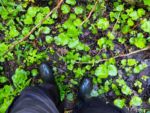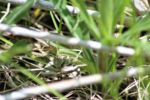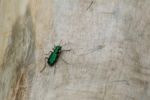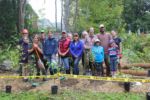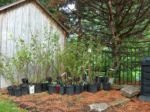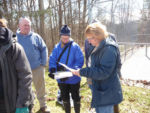Blog Photo Gallery:

Wheel barrows were invaluable in helping to move some of the heavier, and sharp edged materials out to a lay-down area.

As the creek substrate changes from heavy sediment to a more coarsely pebbled bottom, the green frog (Rana clamitans) population will benefit as the predominately worm based benthic population diversifies to include a wider variety of invertebrates, and hence prey species, for tadpoles and adults alike. Newly planted shrubs will also attract terrestrial species such as spiders, caterpillars, butterflies and moths that will be of particular interest to adults, such as the little green frog above, who emerged from hiding shortly after volunteers left for the day. (Photo by Kim Zippel)

Newly planted shrubs will flourish along the banks of Harper Creek and will soon shade the stream with overhanging branches. (Photo by Kim Zippel)

Harper Creek flows directly behind Frank VanHorssen's Fortye Drive home. Frank stopped by the project site to see what our project was all about on Friday, and then generously spent his afternoon helping install logs and prepare the site for planting. Just as we got started Saturday morning, Frank appeared with his wheel barrow, set to dig in for another day. It was wonderful to have a creekside resident so enthusiastic about remediating the stream and we really appreciated his help and local knowledge. (Photo by Kim Zippel).

Michelle Young prepares a spot for a Speckled Alder, one of the larger specimens to be planted near the Pinewood Drive reach of Harper Creek. (Photo by Kim Zippel)

Thomas installs the second anchor as Lauren secures the cable by weaving it around the coir log. (Photo by Kim Zippel)

Lauren uses the 'pile driver' tool to hammer the anchor into the upstream portion of the bank. By placing the anchor upstream, less movement of the log occurs when the strong currents, that occur following a rain event, force the steel tether in the downstream direction. (Photo by Kim Zippel)

Future environmental scientist, Megan Krempa, educates the public on the many benefits of choosing native plants for their gardens. (Photo by Gina Varrin)

Volunteers, Brian Ford and Jess Kroes (left bank) and Andrea Hicks (right bank) carefully position and fasten coir logs in place while John Martin (centre) balances on rocks within the stream in preparation for driving the next anchor.

Lauren Sharkey, CSSP coordinator, and John Martin, HPSI volunteer, attach an anchor to the first coir log to be secured in place.

Scott Kellar from the City of Peterborough forestry department guides the wood chipper into position.

The table provided a great stage for conversation about the stream project, and lots of educational material was given out.

The coir logs were delivered early to the site, and neatly stacked by Rehill Building Supplies staff.

As sediment built up, it became an excellent substrate for emergent plant growth, and vegetation quickly filled in the stream, so much so, that it now resembles wetland habitat. The change between the upper photo, taken by ORCA in 2012, and the above image taken by Kim Zippel in 2013, is remarkable.
![In a 1997 Subwatershed report, the Ministry of the Environment stated that this [Harper Creek] “is the only cold water trout stream which runs through a municipal area within Ontario”. Picture courtesy of Don McLeod.](http://www.harperpark.ca/wp-content/uploads/cache/2017/05/2_Harper_Creek_Don_McLeod/3696744868.jpg)
In a 1997 Subwatershed report, the Ministry of the Environment stated that this [Harper Creek] “is the only cold water trout stream which runs through a municipal area within Ontario”. Picture courtesy of Don McLeod.

The residents of Westview Village have counted as many as 18 deer in the Harper Park herd, including fawns. It is important to maintain wildlife corridors, linkages between natural areas such as the land link between Harper Park and the Parkway Woods, to allow young deer to establish in new territory. If we sever these linkages, animals become “islanded” leading to inbreeding, starvation and disease. Picture courtesy of Rene Gareau.

Purple loosestrife is thriving in the hydric environment associated with the springs feeding the North Tributary. Picture taken August 7, 2012 by Kim Zippel.

L. salicaria growing along the banks of the North Tributary. Picture taken August 7, 2012 by Kim Zippel.














